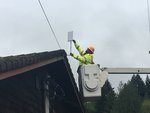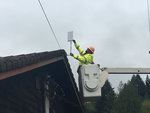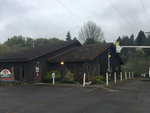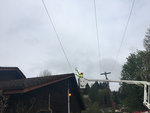



The Lewis County Public Utility District is working with ToledoTel to put in “emergency wireless infrastructure” to create wifi hotspots, some of which are already up and running, in various locations around Lewis County so that individuals, especially students, are able to get reliable access to the internet for free.
At the most recent PUD meeting on Tuesday morning, General Manager Chris Roden and Engineering Manager Jeff Shupe identified six hotspots around the county where fiber-optic telecommunication lines are already in place. The next step to get the internet hotspots up and running is the installation of utility-grade wireless access equipment — similar to a modem and router used for at-home wifi, Roden said.
Within the ToledoTel coverage area, a few wifi hotspot locations are already available to the public — Winlock City Hall, the Winlock Senior Center and Winlock High School. The Van Cleve Ford Dealership is also allowing free access to their building for Morton citizens that need access to internet, ToledoTel COO Dale Merten said.
“The COVID-19 issue that we have right now I think really shines a light on the folks that have and the folks that have not in our community,” Roden said. “When you start heading away from I-5 service really drops off so students that are living in those areas are having a difficult time doing any sort of remote learning.”
A “Proclamation of Need for Reliable, High-Speed Internet Access for Lewis County Students” was signed by all superintendents of the school districts within Lewis County.
The six identified wifi hotspots are located at the Winlock skate park, Stanley Store/Ethel Grange, Salkum (exact location to be determined), Mossyrock High School, Lewis County PUD Morton Office, and the Randle substation. Roden said that the PUD should start work to get these areas and are estimating that the hotspots will be up and running by May 8.
The PUD is partnering with ToledoTel, an internet service provider, to act as the end-use provider of the broadband internet in the hotspot locations while the PUD provides the infrastructure.
“We took a look at places where we already have a fiber backbone in place… we said ‘okay what public facilities do we have around there that you could have high-level wifi access, whether it’s a large parking lot where you can drive in and at least get access to your schoolwork,’” said Shupe.
The main reason for creating these wifi hotspots is so students who do not have reliable internet access at home can get online and work on school work and continue their education during the COVID-19 outbreak and subsequent school closures.
“I think that it’s a great project and a great plan. Of course, I wish that we were into phase three and four now based on what we are experiencing in our school business today. As we provide students with education it really creates an equity issue for us for those students that do have access and those that don’t,” said PUD Commissioner and Chehalis School District Superintendent Ed Rothlin.
Shupe said he used data gathered by the Center for Rural Innovation that allowed him to access the areas of the county that are in the greatest need for improved internet access. In the Pe Ell area, the map shows that more than 64 percent of the population does not have broadband internet access, 74 percent in the Winlock area, and upwards of 96 percent of the population lives without broadband in the Boistfort area.
There are some areas in the county that do not have the fiber optic telecommunication lines installed yet, in the Pe Ell area, for example. Roden said that they have been in the process of getting fiber installed in those areas but now with school being out the need has intensified. Roden said the PUD is working on finding grants that would allow them to speed up installation.
“To get fiber installed out in the west, it requires a pretty large capital spend and it requires a pretty in-depth engineering analysis to be done in order to install the fiber correctly. We are absolutely on a fast track to get a plan in place to take to the different granting agencies. We need a shovel-ready project. Given this emergency, we have fast-tracked the process because we really see this need here,” said Roden.
The next deadline for a grant submission is mid-May and Roden said the engineering team will have something ready to submit for that deadline.
“We have a lot of work to do. I think we can do some really good work. I think it’s pretty prominent just based on some of the data right now the areas that need help,” said Shupe.